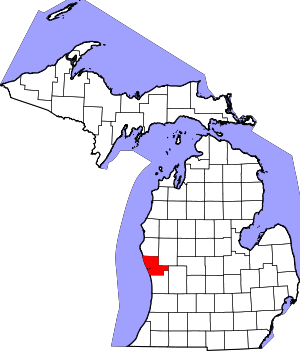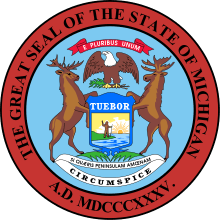Muskegon, Michigan
Muskegon (/mʌˈskiːɡən/) is a city in the U.S. state of Michigan, and is the largest populated city on the western shores of Michigan. At the 2010 census the city population was 38,401. The city is the county seat of Muskegon County.[7] It is at the southwest corner of Muskegon Township, but is administratively autonomous.
Muskegon, Michigan | |
|---|---|
| City of Muskegon | |
| Nickname(s): Lumbertown, Port City, Lumber Queen of the World, Skeetown | |
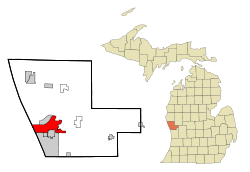 Location of Muskegon within Muskegon County, Michigan | |
| Coordinates: 43°14′03″N 86°14′54″W | |
| Country | United States |
| State | Michigan |
| County | Muskegon |
| Government | |
| • Type | Commission-Manager |
| • Mayor | Stephen J. Gawron [1] |
| • City Manager | Frank Peterson |
| Area | |
| • City | 18.20 sq mi (47.13 km2) |
| • Land | 14.14 sq mi (36.63 km2) |
| • Water | 4.05 sq mi (10.50 km2) |
| Elevation | 617 ft (191.4 m) |
| Population | |
| • City | 38,401 |
| • Estimate (2019)[4] | 36,565 |
| • Density | 2,696.10/sq mi (1,040.94/km2) |
| • Urban | 154,729 |
| • Metro | 1,433,288 (Grand Rapids-Holland-Muskegon metropolitan area) |
| Time zone | UTC−5 (EST) |
| • Summer (DST) | UTC−4 (EDT) |
| ZIP codes | 49440-49445 |
| Area code(s) | 231 |
| FIPS code | 26-56320[5] |
| GNIS feature ID | 1620963[6] |
| Website | http://www.muskegon-mi.gov/ |
The Muskegon Metro area had a population of 154,729 in 2010. It is also part of the larger Grand Rapids-Kentwood-Muskegon-Combined Statistical Area with a population of 1,433,288.[8]
History
Early inhabitants
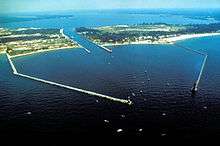
Human occupation of the Muskegon area goes back seven or eight thousand years to the nomadic Paleo-Indian hunters who occupied the area following the retreat of the Wisconsonian glaciations. The Paleo-Indians were superseded by several stages of Woodland Indian developments, the most notable of whom were the Hopewellian type-tradition, which occupied this area, perhaps two thousand years ago.
During historic times, the Muskegon area was inhabited by various bands of the Odawa (Ottawa) and Pottawatomi Indian tribes, but by 1830 Muskegon was solely an Ottawa village.[9] Perhaps the best remembered of the area's Indian inhabitants was the Ottawa Indian Chief, Pendalouan. A leading participant in the French-inspired annihilation of the Fox Indians of Illinois in the 1730s, Pendalouan and his people lived in the Muskegon vicinity during the 1730s and 1740s until the French induced them to move their settlement to the Traverse Bay area in 1742.
The name "Muskegon" is derived from the Ottawa tribe term "Masquigon," meaning "marshy river or swamp".[10]
European arrival

The "Masquigon" River (Muskegon River) was identified on French maps dating from the late seventeenth century, suggesting French explorers had reached Michigan's western coast by that time. Father Jacques Marquette traveled northward through the area on his fateful trip to St. Ignace in 1675 and a party of French soldiers under La Salle's lieutenant, Henry de Tonty, passed through the area in 1679.[13].
The county's earliest known Euro-American resident was Edward Fitzgerald, a fur trader and trapper who came to the Muskegon area in 1748 and who died there, reportedly being buried in the vicinity of White Lake. Sometime between 1790 and 1800, a French-Canadian trader named Joseph La Framboise established a fur trading post at the mouth of Duck Lake. Between 1810 and 1820, several French Canadian fur traders, including Lamar Andie, Jean Baptiste Recollect and Pierre Constant had established fur trading posts around Muskegon Lake.
Euro-American settlement of Muskegon began in earnest in 1837, which coincided with the beginning of the exploitation of the area's extensive timber resources. The commencement of the lumber industry in 1837 inaugurated what some regard as the most romantic era in the history of the region. Lumbering in the mid-nineteenth century brought many settlers, especially ones from Germany, Ireland, and Canada.[14]
Some neighborhoods of Muskegon began as separate villages. Bluffton was founded as a lumbering village in 1862 in Laketon Township. It had its own post office from 1868 until 1892. Muskegon annexed it in 1889.[15]
Geography and climate
According to the United States Census Bureau, the city has an area of 18.12 square miles (46.93 km2), of which 14.21 square miles (36.80 km2) is land and 3.91 square miles (10.13 km2) is water.[16] The city is next to Lake Michigan to the west and Muskegon Lake to the north. The Muskegon River empties into Muskegon Lake at the city's northeast end.
| Climate data for Muskegon, Michigan (1981–2010 normals,[lower-alpha 1] extremes 1896–present) | |||||||||||||
|---|---|---|---|---|---|---|---|---|---|---|---|---|---|
| Month | Jan | Feb | Mar | Apr | May | Jun | Jul | Aug | Sep | Oct | Nov | Dec | Year |
| Record high °F (°C) | 63 (17) |
67 (19) |
82 (28) |
86 (30) |
96 (36) |
98 (37) |
99 (37) |
99 (37) |
95 (35) |
86 (30) |
76 (24) |
66 (19) |
99 (37) |
| Mean maximum °F (°C) | 47.9 (8.8) |
49.5 (9.7) |
67.3 (19.6) |
76.4 (24.7) |
82.3 (27.9) |
88.6 (31.4) |
89.3 (31.8) |
88.2 (31.2) |
84.7 (29.3) |
75.0 (23.9) |
63.4 (17.4) |
50.8 (10.4) |
90.8 (32.7) |
| Average high °F (°C) | 30.8 (−0.7) |
33.2 (0.7) |
43.0 (6.1) |
55.9 (13.3) |
66.9 (19.4) |
76.0 (24.4) |
80.4 (26.9) |
78.8 (26.0) |
71.3 (21.8) |
58.8 (14.9) |
46.4 (8.0) |
35.1 (1.7) |
56.5 (13.6) |
| Average low °F (°C) | 20.1 (−6.6) |
21.1 (−6.1) |
27.0 (−2.8) |
37.3 (2.9) |
46.9 (8.3) |
56.6 (13.7) |
61.9 (16.6) |
61.0 (16.1) |
52.8 (11.6) |
42.5 (5.8) |
34.0 (1.1) |
25.3 (−3.7) |
40.6 (4.8) |
| Mean minimum °F (°C) | −0.7 (−18.2) |
1.8 (−16.8) |
7.2 (−13.8) |
20.2 (−6.6) |
31.8 (−0.1) |
41.4 (5.2) |
47.4 (8.6) |
47.0 (8.3) |
36.0 (2.2) |
27.1 (−2.7) |
20.3 (−6.5) |
7.1 (−13.8) |
−4.1 (−20.1) |
| Record low °F (°C) | −21 (−29) |
−30 (−34) |
−11 (−24) |
1 (−17) |
22 (−6) |
31 (−1) |
39 (4) |
36 (2) |
27 (−3) |
19 (−7) |
−14 (−26) |
−15 (−26) |
−30 (−34) |
| Average precipitation inches (mm) | 2.03 (52) |
1.83 (46) |
2.25 (57) |
2.91 (74) |
3.25 (83) |
2.55 (65) |
2.37 (60) |
3.39 (86) |
3.89 (99) |
3.11 (79) |
3.36 (85) |
2.55 (65) |
33.49 (851) |
| Average snowfall inches (cm) | 28.0 (71) |
19.3 (49) |
9.0 (23) |
2.3 (5.8) |
0 (0) |
0 (0) |
0 (0) |
0 (0) |
0 (0) |
0.2 (0.51) |
6.0 (15) |
28.9 (73) |
93.7 (238) |
| Average precipitation days (≥ 0.01 in) | 15.7 | 12.2 | 11.2 | 12.1 | 10.7 | 9.0 | 9.5 | 9.0 | 10.1 | 11.9 | 14.1 | 15.7 | 141.2 |
| Average snowy days (≥ 0.1 in) | 15.1 | 11.2 | 6.3 | 1.7 | 0 | 0 | 0 | 0 | 0 | 0.3 | 4.0 | 12.9 | 51.5 |
| Source 1: NOAA,[17][18] | |||||||||||||
| Source 2: ThreadEx[19] | |||||||||||||
Geographic features
- Bear Lake
- Muskegon Lake
- Mona Lake
- Lake Michigan
- Muskegon River
Demographics
| Historical population | |||
|---|---|---|---|
| Census | Pop. | %± | |
| 1860 | 1,450 | — | |
| 1870 | 6,002 | 313.9% | |
| 1880 | 11,262 | 87.6% | |
| 1890 | 22,702 | 101.6% | |
| 1900 | 20,818 | −8.3% | |
| 1910 | 24,062 | 15.6% | |
| 1920 | 36,570 | 52.0% | |
| 1930 | 41,390 | 13.2% | |
| 1940 | 47,697 | 15.2% | |
| 1950 | 48,429 | 1.5% | |
| 1960 | 46,485 | −4.0% | |
| 1970 | 44,631 | −4.0% | |
| 1980 | 40,823 | −8.5% | |
| 1990 | 40,283 | −1.3% | |
| 2000 | 40,105 | −0.4% | |
| 2010 | 38,401 | −4.2% | |
| Est. 2019 | 36,565 | [4] | −4.8% |
| U.S. Decennial Census[20] | |||
2010 census
As of the census[3] of 2010, there were 38,401 people, 13,967 households, and 7,895 families residing in the city. The population density was 2,702.4 inhabitants per square mile (1,043.4/km2). There were 16,105 housing units at an average density of 1,133.4 per square mile (437.6/km2). The racial makeup of the city was 57.0% White, 34.5% African American, 0.9% Native American, 0.4% Asian, 2.6% from other races, and 4.5% from two or more races. Hispanic or Latino of any race were 8.2% of the population.
There were 13,967 households, of which 32.5% had children under the age of 18 living with them, 27.9% were married couples living together, 22.9% had a female householder with no husband present, 5.8% had a male householder with no wife present, and 43.5% were non-families. 36.0% of all households were made up of individuals, and 12.8% had someone living alone who was 65 years of age or older. The average household size was 2.38 and the average family size was 3.09.
The median age in the city was 34.1 years. 23.3% of residents were under the age of 18; 12.2% were between the ages of 18 and 24; 28.8% were from 25 to 44; 24.1% were from 45 to 64; and 11.6% were 65 years of age or older. The city's gender makeup was 52.1% male and 47.9% female.
2000 census
As of the census[5] of 2000,[21] there were 40,105 people, 14,569 households, and 8,537 families residing in the city. The population density was 2,794.5 per square mile (1,079.1/km2). There were 15,999 housing units at an average density of 1,114.8 per square mile (430.5/km2). The racial makeup of the city was 57.9% White, 31.7% African American, 2.3% Native American, 0.46% Asian, 0.03% Pacific Islander, 2.69% from other races, and 3.50% from two or more races. Hispanic or Latino of any origins were 6.4% of the population.
There were 14,569 households, of which 31.1% had children under the age of 18 living with them, 33.2% were married couples living together, 20.2% had a female householder with no husband present, and 41.4% were non-families. 34.4% of all households were made up of individuals, and 12.9% had someone living alone who was 65 years of age or older. The average household size was 2.42 and the average family size was 3.13.
In the city, the population was spread out, with 25.8% under the age of 18, 11.6% from 18 to 24, 32.2% from 25 to 44, 18.0% from 45 to 64, and 12.4% who were 65 years of age or older. The median age was 32 years. For every 100 females, there were 109.6 males. For every 100 females age 18 and over, there were 110.3 males.
The city's median household income was $27,929, and the median family income was $32,640. Males had a median income of $29,114 versus $22,197 for females. The per capita income for the city was $14,283. About 16.8% of families and 20.5% of the population were below the poverty line, including 27.6% of those under age 18 and 14.3% of those age 65 or over.
Economy
- Major employers
- ADAC Automotive – Automotive components manufacturing
- Arconic (Whitehall, Michigan, formerly Alcoa) – Aerospace components manufacturing
- Anderson Global (Formerly Anderson Pattern)
- Cannon-Muskegon Corporation – specialty alloys
- Century Foundry
- Cole's Quality Foods – garlic bread, frozen foods
- Consumers Energy –
- Eagle Group
- Fleet Engineers
- GE Aviation – Muskegon, (formerly Johnson Technology) – turbine engine components manufacturing
- Great Lakes Die Cast (formerly Dilesco)
- Kaydon Corp – Precision Bearings
- Knoll Inc.
- L3 Communications (formerly Teledyne) – armored vehicle manufacturing
- Mahle (formerly Dana (formerly Sealed Power)) – piston rings – aerospace
- Meijer
- Mercy Health – Member of Trinity Health
- Michigan's Adventure – amusement park (Michigan's largest amusement park and water park)
- Nugent Sand
- Port City Group
- Pratt & Whitney Component Solutions – a Raytheon Technologies Company
- SAF-Holland – Muskegon (formerly Neway Equipment Company) – Commercial vehicle axles, suspensions and coupling devices
- Wesco, inc. (Headquarters)
- Shopping
In 1976, Muskegon Mall was built in downtown Muskegon, featuring Sears, Steketee's, and Hardy's-Herpolsheimer's. A second mall, The Lakes Mall, was built southeast of town in 2001, resulting in the closure of Muskegon Mall and the rebirth of the City's traditional downtown.
Other retail sectors include Apple Avenue, Sherman Boulevard, and Henry Street.
Government
The city levies an income tax of 1 percent on residents and 0.5 percent on nonresidents. [22] The Michigan Department of Corrections operates the Muskegon Correctional Facility in southeastern Muskegon. The prison first opened in 1974.[23]
Education
Muskegon Public Schools was founded in 1860 and serves students from preschool through 12th grade. Additionally, it runs the Muskegon Museum of Art and the Muskegon Training and Education Center. In addition to Muskegon Public Schools, Muskegon is served by these private K-12 schools: Muskegon Catholic Central, Fruitport Calvary Christian, and Western Michigan Christian.[24]
In 2010, North Muskegon High School was noted as the top performing public school in the State of Michigan by the state Department of Education.[25]
The City of Muskegon is also served by Muskegon Community College and Baker College.
Grand Valley State University's Muskegon Campus is home to the Muskegon Innovation Hub (formerly MAREC) and Annis Water Resources Institute (AWRI) inside the Lake Michigan Center in downtown Muskegon.
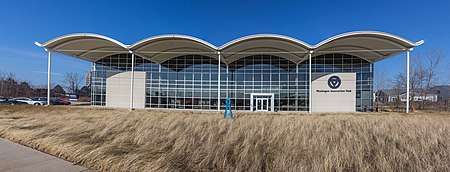
Western Michigan University, Ferris State University, and Grand Valley State University all operate programs out of the Stevenson Center for Higher Education on the campus of Muskegon Community College. It is designed so an undergraduate at MCC may transfer to any of the above schools and complete a bachelors and/or master's degree without leaving Muskegon.
Culture and recreation
Music and fine arts
Muskegon County is home to Blue Lake Fine Arts Camp, in the Manistee National Forest in the town of Twin Lake.
Once a movie house, the Frauenthal Center for the Performing Arts[26] includes two theaters (the main Frauenthal house and the smaller Beardsley Theater in the adjoining Hilt Building). It was refurbished in 1998, and runs JAM Theatrical productions, Muskegon Civic Theatre[27] productions, is home of the West Michigan Symphony Orchestra,[28] was the venue for all Muskegon Community Concert Association[29] events, and used to be home to the now-defunct Cherry County Playhouse. The Frauenthal was originally built as the Michigan Theater in 1929.
Muskegon also has one of the founding chapters of the Barbershop Harmony Society.
Muskegon also houses a moderate-sized private collection of fine art in the Muskegon Museum of Art.[30]
Festivals
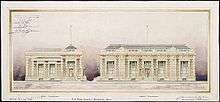
A lackluster attendance in 2011 caused the cancellation of the 2012 Muskegon Summer Celebration festival.[31] A new festival, Rockstock (formerly Coast West[32]) has taken its place.[33] The Art Fair also returned in 2013.[34] The Art fair has grown to become one of the largest and well-attended art fairs in the State of Michigan.
Muskegon Bike Time[35] is held every July. The most well-attended aspect of Bike Time is Rebel Road – a 6 block stretch of Western Avenue in downtown Muskegon, when 50,000+ bikes and more than 100,000 visitors spend much of the 4-day festival. More than 100,000 people attended Bike Time and Rebel Road in 2016.
The Muskegon Motorcycle Club, organized in 1920, hosts the Hill Climb every other year, an American Motorcycle Association (AMA) sanctioned race.
The Muskegon Film Festival[36] is held in May.
Each August, the Unity Christian Music Festival takes place at Heritage Landing. In May, Rock the Coast[37] takes place at Michigan's Adventure. Both are organized by Alive on the Lakeshore.
In September, the Michigan Irish Music Festival brings renowned Celtic musicians to Heritage Landing on the shore of Muskegon Lake. Artists have included Tommy Makem, Gaelic Storm, Slide, The Old Blind Dogs, Scythian and many more. In addition to music, Irish food, beverages, merchandise and cultural exhibits contribute to the appeal of this event. The Michigan Feis (Irish Dance competition) is affiliated and is held at Muskegon Catholic Central High School.
Muskegon also plays host to Moose Fest each August, as well as the Muskegon Polish Festival each September.
In early October, the International Buster Keaton Society visit Muskegon to host their annual convention.[38] The event features public showings of Keaton films at the Frauenthal Theater.
Museums and theater

Broadway at the Frauenthal (fall through spring) brings Broadway musicals to Muskegon. Muskegon is also home to Muskegon Museum of Art and West Michigan Symphony Orchestra. The Muskegon Community Concert Association provides concerts from September through May.
Lakeshore Museum Center (formerly known as Muskegon County Museum)[39] and Hackley & Hume Historic Site: Mansions built by Muskegon's lumber barons themselves are restored to their old glory and open to the public. The Hackley & Hume mansions are part of downtown Muskegon's Heritage Village—two blocks from Muskegon Lake, and a National Register Historic District. The mansions are operated with the Lakeshore Museum Center, which details the grand, rich history of Muskegon County, from the Pottawatomi and Ottawa Native American tribes and lakeside fur traders to the Lumber Queen of the World to today. Also includes science and nature exhibits.
The Muskegon Museum of Art is touted as one of the finest art museums in the Midwest. Among the highlights of its permanent collection is Tornado Over Kansas, by John Steuart Curry (one of three leading painters, along with Grant Wood and Thomas Hart Benton, identified as Regionalists and known for their canvases celebrating the rural Midwest).[40]
Muskegon is also the home of the USS Silversides Submarine Museum[41] which features USS Silversides, a World War II submarine; USS LST-393, a World War II tank landing ship; and USCGC McLane, a Prohibition-era United States Coast Guard cutter.
In addition, Muskegon also berths Milwaukee Clipper, a former car ferry that traveled the same route as Lake Express does today. The ship (which is a National Historic Landmark) is in the middle of a long process of being restored to its original form, but in the meantime is open for tours and hosts a museum aboard the vessel with information on both Milwaukee Clipper, as well as the history of maritime in Muskegon. Muskegon is an historical port for commerce and lake travel. The lumbering era through World War II was its busiest historical use. Its image as a port the city has embraced with the local nickname 'The Port City'. It possesses a fine deep-water port and still functions delivering bulk cement, aggregate, and large cargoes to several lakeshore facilities, also coal to the B.C. Cobb power plant, an outdated coal-burning facility due to shut down.
- The Muskegon Heritage Museum-The Muskegon Heritage Association is non-profit corporation founded in 1973 to promote the enhancement of Muskegons Historic Resources. One of the MHA's missions is to maintain a museum to show the economic, industrial and social history of the greater Muskegon area. The Museum was begun by the MHA in 1983 to accommodate the donated Corliss Valve 90 hp steam engine. The museum's goal is to preserve information, photos and artifacts pertaining to: The Industries of the Muskegon Area, Historic/Heritage Homes and Businesses of Muskegon. In 2009 a revitalization of the museum began with a complete rearrangement of the main room adding new displays in the cases and on the walls. A print shop was set up and an Industrial section in the back building was rearranged. Printed signs for all displays were added. In 2010 the museum was expanded into what was the shoe store next door. During 2011-2012 we reconfigured and remodeled the second floor of the building where the Corliss Engine is housed. This is a "Made in Muskegon" exhibit. The museum also added a classroom that accommodates 35 people comfortably with all the AV equipment necessary for any presentation.
- Carr-Fles Planetarium, Muskegon
- The Muskegon Area Sports Hall of Fame exhibits, detailing the area's rich athletic past, are on display at the L.C. Walker Arena.
Outdoor recreation
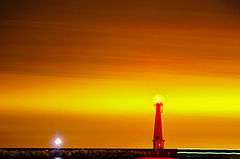
Muskegon State Park has a Winter Sports Complex that features ice fishing, cross-country skiing, ice skating, and a Luge track.
P.J. Hoffmaster State Park has many sand dunes as well as two campgrounds and a public beach for tourists to enjoy.[42]
Pere Marquette Beach is the largest free public beach on the western shore of Lake Michigan, and one of the loveliest in the state. Windsurfing, kite boarding competitions, and professional volleyball tournaments are held there. Its quartz sand beach is a Clean Beaches Counsel certified beach. The beach area is popular with cyclists, runners and hikers, and sand dunes border the beach to the east.
Muskegon Lake is a first class walleye fishery and has many other freshwater species including the Lake Perch. Lake Michigan off Muskegon hosts large numbers of coho and Chinook salmon, steelhead, brown trout, lake perch and many other game fish.
Sailing and recreational boating are major summer pastimes with many services and marinas in the area for boats of all sizes.
Muskegon Lakeshore Bike Trail allows for biking along the shores of Muskegon Lake to Lake Michigan. There are two trails that consist the Muskegon bike paths, one runs along the east side of Muskegon and the other along the north side.
Michigan's Adventure, the largest amusement park in the state, is in Muskegon County, a few miles north of the city of Muskegon. Michigan's Adventure features a midway with roller coasters, general rides, amusements, and a full water park.
Sports
| Club | Sport | League | Venue |
|---|---|---|---|
| Muskegon Lumberjacks | Ice hockey | United States Hockey League | L.C. Walker Arena |
| West Michigan Lake Hawks | Basketball | American Basketball Association | Reeths-Puffer High School |
| Muskegon Mustangs | Football | Great Lakes Football League | Oakridge High School |
| West Michigan Ironmen | Indoor football | American Arena League | L.C. Walker Arena |
| Muskegon Risers SC | Soccer | UPSL & Premier Arena Soccer League | L.C. Walker Arena and Kehern Stadium |
Previous sports teams to play in Muskegon have included:
| Club | Sport | Played from | League | Stadium |
|---|---|---|---|---|
| Muskegon Lumberjacks/Fury (1992–2010) | Hockey | 1992−2010 | IHL, UHL | L.C. Walker Arena |
| Muskegon Thunder | Indoor football | 2007−2009 | IFL | L.C. Walker Arena |
| Michigan Mayhem | Basketball | 2004−2006 | CBA | L.C. Walker Arena |
| Muskegon Lumberjacks (1984–1992) | Hockey | 1984−1992 | IHL | L.C. Walker Arena |
| Muskegon Mohawks | Hockey | 1965−1984 | IHL | L.C. Walker Arena |
| Muskegon Zephyrs | Hockey | 1960−1965 | IHL | L.C. Walker Arena |
| Muskegon Lassies | Baseball | 1946−1949 | AAGPBL | Marsh Field |
The Chronicle Seaway Run is run every year in late June. It features a 15k race, 5k race, 5k walk for fun, 15k wheelchair race.
Media
- Muskegon's leading newspaper is The Muskegon Chronicle. The Chronicle is a daily newspaper in Muskegon, Michigan owned by Booth Newspapers. It started publication in 1857.
- Muskegon is served by several local television channels:
- WMKG-CD 38 is a low-powered television station serving the area. This station features a homey mix of programming such as television bingo and Dial-A-Bargain. The Dial-A-Bargain show includes a host reading menus from various local eateries. Viewers may then call in and purchase certificates for that particular establishment at 50% off the regular price.
- DSETV-97 is the locally-run Government-access television (GATV) cable TV channel based out of City Hall Privately ran by Digital Spectrum Enterprises on Comcast Cable Channel 97. It features live televised City Hall meetings as well as a long list of locally made television shows showcasing Muskegon. It also is home to local sporting events.
- MCCTV-98 is Muskegon Community College's television outlet on Comcast Cable Channel 98.
- WWMT-TV 3 (CBS and CW), WOOD-TV 8 (NBC), WZZM-TV 13 (ABC), WXMI-TV 17 (FOX), WOMS-TV 29 (MNTV), WGVU-TV 35 (PBS), WOTV (ABC), WZPX (ION), and WTLJ-TV 54 (TBN). Green Bay, Milwaukee, South Bend, and Chicago affiliates are also common in the warmer months.
- Comcast holds the local cable franchise.
- The Muskegon area is also served by several radio stations. WUVS-LP 103.7 is a popular urban (hip-hop/R&B) and gospel station with local programming as well as Sunday religious programming and local-based talk. Another local low-powered FM station is WUGM-LP 106.1, owned by the Muskegon Training and Education Center, which airs an Urban Oldies format dubbed "M-TEC 106 FM, Rock 'n' Soul." A Newer LP-FM Station WFFR-LP 100.9 also offers local programming along with a classic hits format. The station is based out of nearby Roosevelt Park.
- Local radio talk shows include the Ramona Show on WKBZ 1090. On this show the host interviews local small business people. A once-a-week, Friday afternoon show on the same station is called "Talking Muskegon". "Talking Muskegon" is hosted by local celebrity Jon Van Wyke. It features homey conversations about area nightlife, his work life and volunteer activities, and the state of the professional hockey team the Muskegon Fury. Usually the show is co-hosted.
- Other local FM stations include 90.3 WBLV-FM (classical/jazz/NPR), 91.7 WMCQ-FM (religious), WWSN FM 92.5 (adult contemporary), WGVS-FM 95.3 (public radio), WLAW FM 97.5 (country), WLCS-FM 98.3 (oldies), WVIB-FM 100.1 (urban contemporary), WMRR-FM 101.7 (classic rock), WSNX-FM 104.5 (top 40, studios in Grand Rapids), WMUS-FM 106.9 (country), and WMUS FM 107.9 (adult contemporary). Other local AM stations aside from WKBZ include WGVS 850 (NPR), WBBL 1490 (sports), and WMHG-AM 1600 (adult standards). Other area stations can be received from Grand Haven (WGHN-FM 92.1, adult contemporary), Grand Rapids (WGRD-FM 97.9), Ludington, Holland, Zeeland (WJQK-FM 99.3, Christian pop), and Milwaukee.
- Clear Channel Communications is the major radio-station owner in Muskegon, owning WKBZ-AM, WSHZ-FM, WMUS-FM, WMRR-FM and WMHG-AM, as well as WSNX (although WSNX is considered primarily a Grand Rapids station despite being licensed to Muskegon). Citadel Broadcasting owns WODJ-AM, WLAW-FM, WEFG-FM, WLCS-FM and WVIB-FM.
Transportation
Public transportation is provided by the Muskegon Area Transit System (MATS – "The Shore Line"), which operates nine bus routes, three trolley routes, and a paratransit system.[43] MATS and Greyhound serve the Herman Ivory Passenger Terminal.[44]
MATS operates the Muskegon Trolley Company. Three routes cover north side, south side, and downtown; each trolley stops at 11 locations, including Hackley and Hume Historic Site, USS Silversides, Muskegon State Park. (Memorial Day-Labor Day, daily; no trips during special events).
Commercial air service is provided by United Airlines at Muskegon County Airport (MKG). Other airlines service the Gerald R. Ford International Airport (GRR) in Grand Rapids.
Muskegon is the eastern port of the Lake Express High Speed Car Ferry that crosses Lake Michigan to Milwaukee, Wisconsin offering three roundtrips a day in the summer, and two roundtrips in the fall. There are many bike paths starting to be built around the area.
CSX Transportation along with the Michigan Shore Railway provide rail service for many of Muskegon's industries. Rail passenger services ended in the 1960s. The nearest passenger rail available is via Amtrak in nearby Holland or Grand Rapids.
Several major highways serve the city, including:
Sister cities



Notable people
Noteworthy
- Virginia Bell, who served for the Women's Army Corps in Japan during World War II, and later joined the All-American Girls Professional Baseball League as a ballplayer[45]
- John Beyrle, son of Joseph Beyrle, appointed as United States Ambassador to the Russian Federation on May 13, 2008, confirmed July 3, 2008.
- Joseph Beyrle, only soldier to have served in both the US Army and the Soviet Army in World War II
- Nancy Anne Fleming, Miss America 1961
- Mark Grimmette, Olympic luger
- George Edward Hilt, founder of the nation's largest farm-store retailer
- David Leestma, astronaut
- Harry Morgan, actor in films and popular Dragnet and M*A*S*H television series
- Earl Morrall, NFL quarterback
- Don Nelson, NBA Basketball Player for Boston Celtics, NBA basketball coach, University of Iowa Basketball All-American
- Frank Stanton, past president of CBS, member of Television Hall of Fame
- Vonda Kay Van Dyke, Miss America 1965
- Richard Versalle, opera singer
- Captain Jonathan Walker, "The Man With Branded Hand" abolitionist
Business and politics
- Charles Hackley (1837–1905), lumber baron, philanthropist (Hackley Hospital, Hackley Library, Hackley Administration Building, Hackley Avenue, Hackley Art Gallery, Hackley Park); after a gift of $12,000,000 to the community, the city of Muskegon considered changing its name to "Hackleyville"
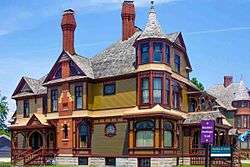
- Richard Mell, politician
Religion
- Jim Bakker, TV evangelist
- Edmund Cardinal Szoka, cardinal, President Emeritus of the Pontifical Commission for Vatican City State
Science and technology
- Clara H. Hasse (1880–1926), botanist
- W. Wesley Peterson, mathematician and computer scientist, best known for inventing the Cyclic Redundancy Check (CRC)
Artists
- Haddon Sundblom, graphic arts designer, best known for his images of Santa Claus for Coca-Cola
Authors
- Laurie Keller, children's book writer and illustrator best known for The Scrambled States of America and Grandpa Gazillion's Number Yard
- John Frederick Nims, poet
- Lewis B. Smedes, theologian and author
- Bob Wood, author of Dodger Dogs to Fenway Franks and Big Ten Country
Music
- Steve Gorman, drummer, Black Crowes, born in Muskegon
- Rick Johnson, musician, bass player for Mustard Plug
- Bettye LaVette, soul singer
- Iggy Pop, punk rock icon
- Wayne Static, lead singer and guitarist for industrial metal band, Static-X
- Bill Szymczyk, music producer of the Eagles, The Who and others
- Gerry Teifer, music publisher, songwriter, performer
- Børns, singer and songwriter, born in Muskegon
Stage
- Buster Keaton, iconic comedian and film director; born in Kansas but spent childhood summers in Muskegon with his family as a member of the Muskegon Actors' Colony;[46] as a vaudevillian who traveled constantly in non-summer months, Keaton always regarded Muskegon as his home town.
- Kate Reinders, Broadway actress known for playing the role of Glinda in Wicked and Caroline in Good Vibrations
Television
- Harry Morgan, versatile stage, film and TV actor best remembered as Colonel Potter on the TV series M*A*S*H (1972–1983)
- Frank Stanton, former president of CBS
Sports
- Justin Abdelkader – NHL player, Detroit Red Wings
- Curtis Adams – NFL player, San Diego Chargers
- Beatrice Allard – All-American Girls Professional Baseball League player
- Donna Cook – AAGPBL player
- Doris Cook – AAGPBL player
- Deyonta Davis – NBA player, Memphis Grizzlies
- Paul Dekker – NFL and CFL player
- Miss Dougal – AAGPBL player, 1953 Muskegon Belles
- Tony Ferguson – winner of Ultimate Fighter Season 13
- Bill Green – hammer thrower, former U.S. record holder, 5th place in 1984 Olympic Games; visiting son to resident William Hipkiss, attorney and stage performer in productions at Frauenthal Center for the Performing Arts
- Bobby Grich – MLB All-Star second baseman for the Baltimore Orioles and California Angels
- Mark Grimmette – men's double luge, winner of Olympic silver (2002) and bronze (1998) medals
- Mark Hughes – basketball player and coach
- Ronald Johnson – University of Southern California and San Francisco 49ers wide receiver
- Alta Little – AAGPBL player
- Ruvell Martin – NFL player for the Seattle Seahawks
- Beulah McGillicutty – manager in Extreme Championship Wrestling
- Nate McLouth – MLB player for the Washington Nationals
- Earl Morrall – Michigan State and NFL quarterback, three-time Super Bowl champion
- Robert Morse – NFL player for the New Orleans Saints
- Drew Naymick – professional basketball player
- Don Nelson – NBA player for Boston Celtics and coach in Basketball Hall of Fame, University of Iowa basketball player
- Ray Newman – MLB pitcher
- Bennie Oosterbaan – three-time University of Michigan All-American football player and head coach
- Marley Shriver - Olympic swimmer
- Terrance Taylor – Detroit Lions defensive tackle
See also
References
- Mean monthly maxima and minima (i.e. the highest and lowest temperature readings during an entire month or year) calculated based on data at said location from 1981 to 2010.
- "City of Muskegon". Retrieved 2012-12-28.
- "2017 U.S. Gazetteer Files". United States Census Bureau. Retrieved Jan 3, 2019.
- "U.S. Census website". United States Census Bureau. Retrieved 2012-11-25.
- "Population and Housing Unit Estimates". Retrieved May 21, 2020.
- "U.S. Census website". United States Census Bureau. Retrieved 2008-01-31.
- "Muskegon". Geographic Names Information System. United States Geological Survey.
- "Find a County". National Association of Counties. Archived from the original on 2011-05-31. Retrieved 2011-06-07.
- Population of Michigan Regions and Statistical Areas, 2000 and 2010, at www.michigan.gov
- Helen Hornbeck Tanner. Atlas of Great Lakes Indian History. (Norman: University of Oklahoma Press, 1987) p. 134
- Sherman, Elizabeth B. (2003). Beyond the Windswept Dunes: The Story of Maritime Muskegon, p. 2. Detroit: Wayne State University Press. ISBN 0-8143-3127-0.
- "Archived copy". Archived from the original on 2016-06-07. Retrieved 2016-04-06.CS1 maint: archived copy as title (link)
- Alexander, Dave (May 11, 2012). "Water Runs Through Us: For fur traders to industrialists, Muskegon Lake gave plenty". Mlive. Retrieved 6 April 2016.
By 1837, those seeking the resources of the woods discovered that the Muskegon River provided the perfect transportation link for the lumber companies' logs. The Muskegon River from Houghton Lake to Muskegon was on the southern edge of the vast white pine forests of Northern Michigan. Those logs could be brought in bulk down the river to Muskegon Lake, where eventually 47 sawmills were built.
- "History of Muskegon". co.muskegon.mi.u. Retrieved 7 June 2019.
- "History of the Churches of St. Mary's, Our Lady of Grace & St. Jean Baptiste". Our Lady of Grace & St Mary Catholic Parishes, Muskegon. Retrieved 9 July 2015.
- Walter Romig, Michigan Place Names, p. 68
- "US Gazetteer files 2010". United States Census Bureau. Archived from the original on 2011-02-20. Retrieved 2012-11-25.
- "NOWData – NOAA Online Weather Data". National Oceanic and Atmospheric Administration. Retrieved 2018-10-10.
- "Station Name: MI MUSKEGON CO AP". National Oceanic and Atmospheric Administration. Retrieved 2018-10-10.
- "Thread Stations Extremes". National Oceanic and Atmospheric Administration. Retrieved 2011-01-29.
- "Census of Population and Housing". Census.gov. Retrieved June 4, 2016.
- "Muskegon, Michigan". city-data.com.
- Gibbons, Lauren (August 16, 2017). "Michigan State University, city of East Lansing at odds over proposed income tax". MLive Lansing. Mlive Media Group. Retrieved August 16, 2017.
- "Muskegon Correctional Facility (MCF). Michigan Department of Corrections. Retrieved on June 3, 2011.
- "District Information". muskegonpublicschools.org. Archived from the original on 26 October 2015. Retrieved 11 November 2015.
- "North Muskegon High School top-performing in state; Muskegon Heights the lowest". MLive.com.
- "Frauenthal Center for Performing Arts". frauenthal.org.
- "Muskegon Civic Theatre". muskegoncivictheatre.org.
- "West Michigan Symphony Orchestra". westmichigansymphony.org. Archived from the original on 2013-06-17.
- "Muskegon Community Concerts – Home". muskegonconcerts.org. Archived from the original on 2016-04-03. Retrieved 2008-08-29.
- "Muskegon Museum of Art". muskegonartmuseum.org.
- "Muskegon Summer Celebration Will Not Return In 2012". Channel 95.7.
- "coastwestfestival.com". coastwestfestival.com. Archived from the original on 2 January 2016. Retrieved 11 November 2015.
- Alexander, Dave (February 9, 2012). "New Muskegon music festival to have a different look and feel, organizers promise". Muskegon Chronicle. Archived from the original on August 18, 2013. Retrieved March 27, 2013.
- "Muskegon summer art fair re-emerges as Lakeshore Art Festival". grbj.com.
- Super User. "Muskegon Bike Time – Home". muskegonbiketime.com.
- "muskegonfilmfestival.com". muskegonfilmfestival.com. Archived from the original on February 8, 2009.
- "Rock the Coast is back for 2013 - May 24-25". rockthecoast.net. Archived from the original on 2013-06-23. Retrieved 2013-06-27.
- "2014 Buster Keaton Convention". busterkeaton.com. Archived from the original on 2016-03-23. Retrieved 2016-07-02.
- http://www.muskegonmuseum.org/about_us.html Archived October 21, 2014, at the Wayback Machine
- Archived September 28, 2007, at the Wayback Machine
- silversidesmuseum.org
- "P.J. Hoffmaster State Park". michigandnr.com. Archived from the original on 2015-11-17.
- "MATS History". www.co.muskegon.mi.us. Archived from the original on 2007-10-09. Retrieved 2009-05-06.
- sklooste@mlive.com, Stephen Kloosterman (2015-07-30). "Muskegon's new $2.8M downtown bus station to open Saturday". MLive.com. Retrieved 2016-11-21.
- Madden, W. C. (2005) The Women of the All-American Girls Professional Baseball League: A Biographical Dictionary (2005). ISBN 978-0-7864-2263-0
- "Muskegon Actors' Colony – Home Page". actorscolony.com.
External links
| Wikivoyage has a travel guide for Muskegon. |
| Wikimedia Commons has media related to Muskegon, Michigan. |
